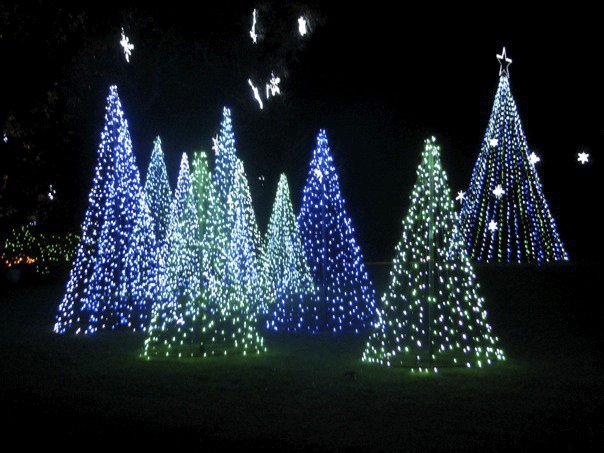
by Carrie Stevenson | Nov 25, 2014
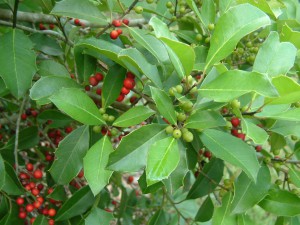
The Savannah holly has beautiful leaves and berries throughout the winter. Photo credit: Carrie Stevenson
As the holiday season comes upon us, many folks will be spending their weekends scouring tree farms and mall parking lots for the perfect Christmas tree. There are many very realistic-looking options for artificial trees these days, and they are a great way for families to reduce waste by reusing the same tree year after year. However, a live Christmas tree brings greenery inside, smells wonderful, and provides a central focus for many of our holiday traditions. Many cut trees will last over a month with good watering, but when the holidays are over, what do you do with your tree?
Many cities and counties offer a Christmas tree recycling program, in which trees can be left at drop-off sites or on the curb for pickup. Most municipalities turn the trees into mulch and use it at public facilities. Many individuals reuse trees by placing them in lakes or other water bodies as fish habitats, creating reefs for hiding and nesting. However, be sure and check with local environmental agencies before placing trees under water. If you own a good bit of land or a wooded area, you can lay your old tree out for small mammals and birds to use as shelter. It will eventually biodegrade and add nutrients to the soil. Be sure that if you take advantage of any of these recycling options that you remove all ornaments, tinsel, or other decorations which could be hazardous to animals and/or wood-chipping machines.
There is an option to truly keep your tree evergreen—a live Christmas tree! Many retailers sell potted trees that can be brought inside and decorated, then planted outside after the season is over. One of the plants often associated with this festive time of year is holly, which is an excellent choice for evergreen color throughout the year. There are many native varieties, such as yaupon holly for drier areas and myrtle-leaved holly for wetlands. Hollies are typically used as shrubs in the landscape, although many species can grow into small trees if allowed; the East Palatka holly can be as tall as 45 feet at maturity! Hollies are also an excellent food choice for attracting birds, and the shrubs work wonderfully as a natural screen. While their branches aren’t quite as sturdy as some of the northern varieties, native Atlantic white or Eastern red cedar–or even some local pines–are also excellent evergreen species that can be used.
A live tree or one planted and decorated outdoors is a wonderful way to commemorate a special Christmas and help provide wildlife habitat year-round.
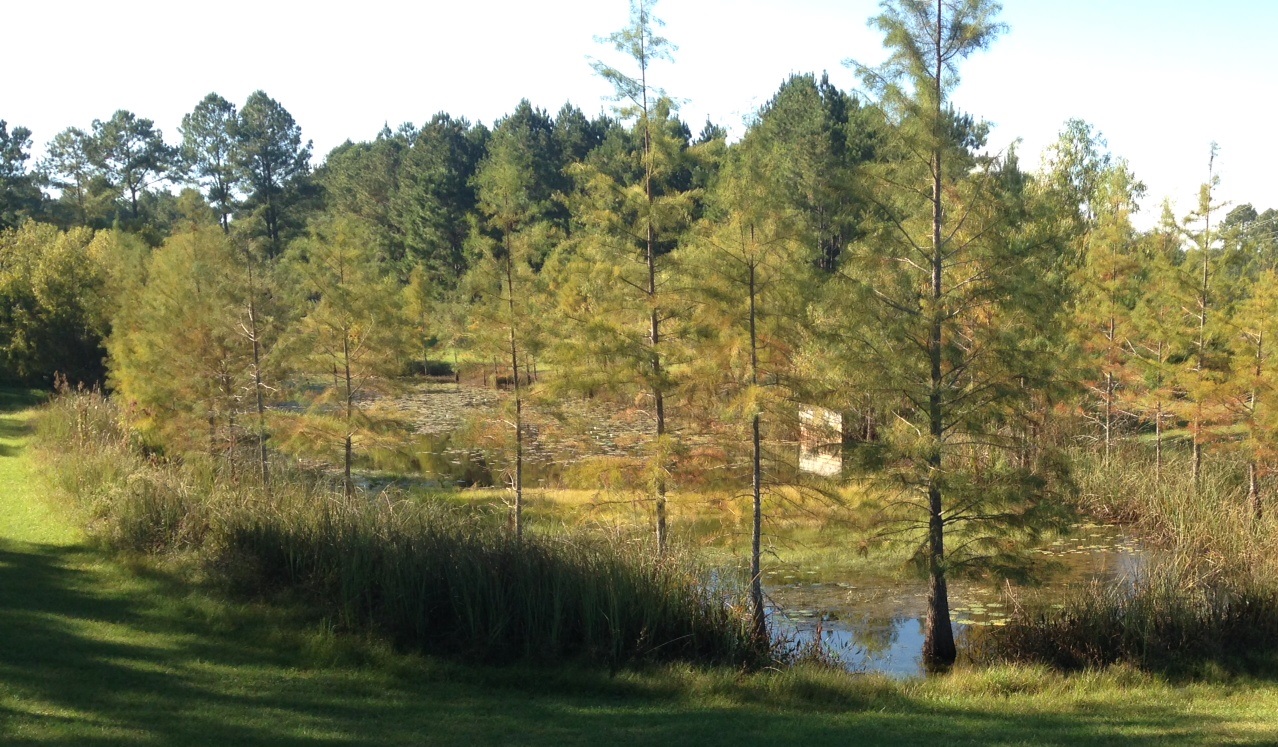
by Carrie Stevenson | Nov 4, 2014
I recently met with a group of community volunteers who are interested in providing more butterfly habitat in our public areas. Monarchs migrating to Mexico this time of year use northwest Florida as a stopover and feeding site, but if host plants are unavailable they cannot sustain a healthy population. In addition, Gulf fritillaries, buckeyes, and swallowtails are spending time in local butterfly gardens, feeding on passion vine, butterfly bush, milkweed, and more.
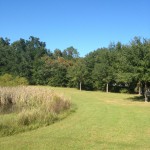
The grassy area between this stormwater pond and woods is an ideal location for a butterfly garden. Willows growing along the edge attract butterflies already. Photo credit: Carrie Stevenson
The volunteers and several county staff visited three publicly-managed stormwater ponds, which are an ideal setting for what some proponents term “Butterflyscaping.” The open space, water source, and diversity of plants along the edge of the ponds lend themselves well to wildlife habitat.
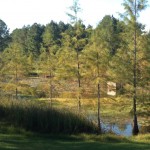
The permanently wet detention pond lined with cypress trees and sawgrass also provides habitat for fish, birds, and reptiles. Photo credit: Carrie Stevenson
When considering adding vegetation to a neighborhood common area, there are several things to consider. First is maintenance. If there’s an annual contract with a landscaping company to mow or maintain an area, you’ll want to have a discussion about excluding the new planting area from mowing to establish new vegetation. You’ll also want to look at the soil and amount of sunlight to determine the best plant choices for the area.
A variety of groundcovers, flowering plants, shrubs and small trees will typically provide food for both caterpillars and adult butterflies. Once established, these new landscape additions will not only provide habitat and color, but may end up reducing maintenance costs as well.
For more information, the UF publication “Community Butterflyscaping” is an excellent resource for landscape design, plant choices, and practical steps toward getting started with a neighborhood or schoolyard project.
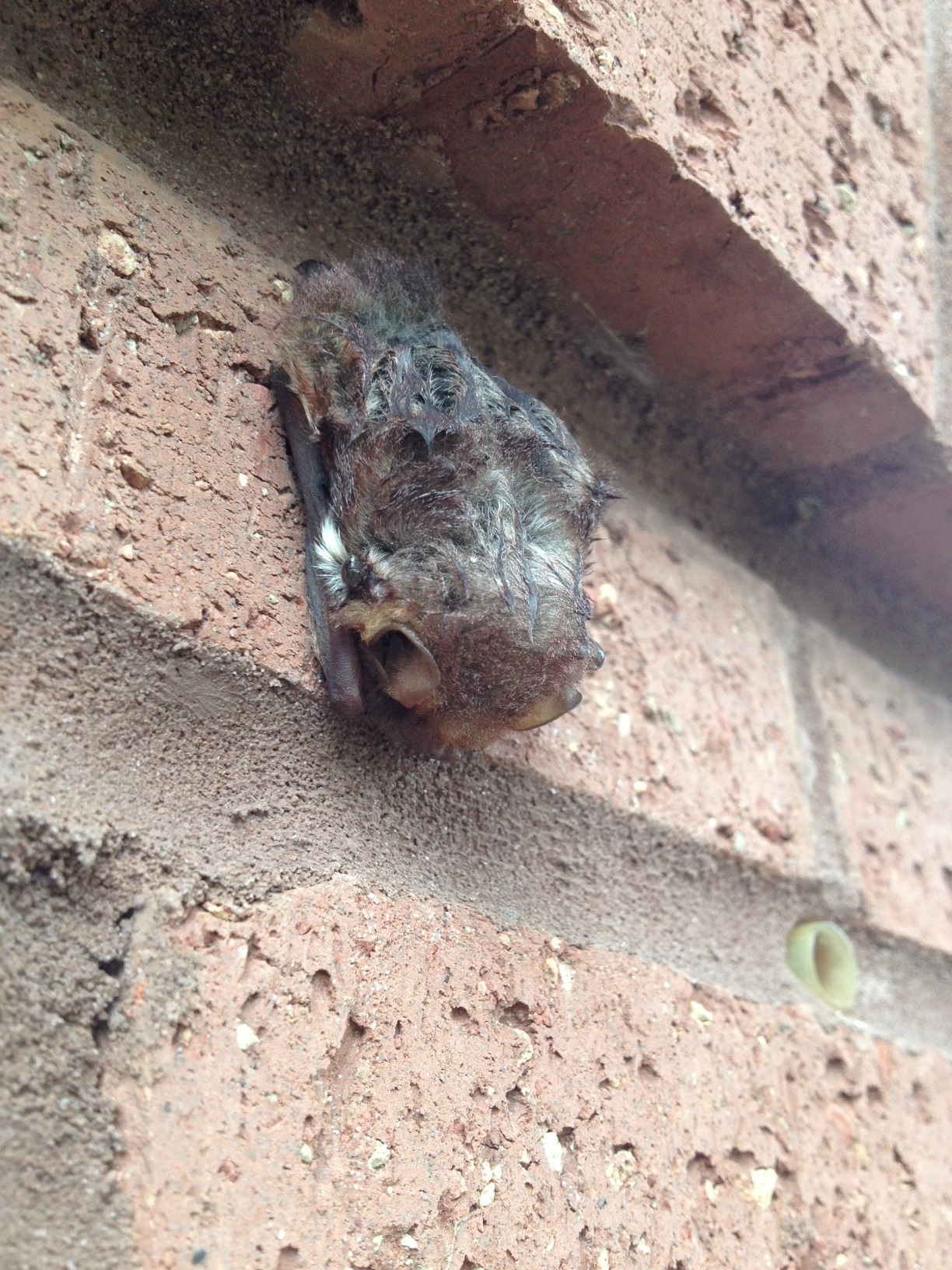
by Carrie Stevenson | Sep 30, 2014
Last week, the Okaloosa County Health Department issued a rabies alert after three bats were determined to have the illness. A “drive-through” rabies vaccine clinic was organized for pets, and warnings were issued throughout the region about making contact with wild animals. One radio broadcast played an interview in which a health department staffer urged people “not to attract wildlife to your yard.” While they were focusing on unsecured trash and pet food, I found this advice unsettling, for as an Extension Agent I’ve promoted the practice of attracting wildlife to yards for many years—birds, butterflies, and even (especially) bats. Raccoons, not bats, have the greatest incidence of rabies (based on data collected from 1992-2011), by a factor of almost seven times that of bats. In the scare of a rabies outbreak, it can be easy to overreact or overlook the many benefits that wildlife provide to our neighborhoods.
There are, of course, practical ways to go about living with wildlife without endangering your health or that of your family and pets (including making sure pets have the rabies vaccine).
Use Caution around Injured Wildlife
Most wildlife rescue organizations do not have the staff to pick up injured animals and ask those who find one to bring them in. However, sick or injured animals may respond aggressively as an intuitive protective measure. If you are taking an animal to a wildlife rehabilitator, be sure to approach it gently and use a blanket or large towel to pick up the animal, and place it gently in a box with a ventilated lid. Great information on responding to injured or deserted animals can be found at the Wildlife Sanctuary of Northwest Florida website. Keep in mind that bats are flying animals and spend almost no time on the ground. They do not chase people and are primarily concerned with catching insect prey. If you find a bat on the ground, it is most likely sick. County animal control or private wildlife responders can also help if you are concerned about interacting with a sick animal.
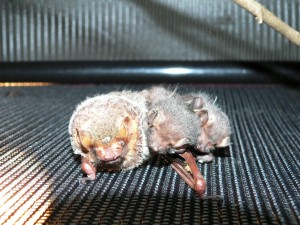
These twin Seminole bat pups were found on the ground with their mother and nursed back to health at the Wildlife Sanctuary of Northwest Florida. Photo credit: Carrie Stevenson
Use Care When Retrieving Dead Animals
When bird flu, West Nile or rabies hits an area, health departments sometimes ask that suspect animals be reported for testing to confirm the cause of death. Even if you are just disposing of the animal, be sure to use gloves and place the animal in a sealable plastic bag to prevent spreading germs, and wash your hands after handling it. If burying, place at least three feet deep and away from wells or water sources.
Enjoy Wildlife from a Distance
Disturbing healthy animals while they are feeding or resting can cause unnecessary stress and reduce their hunting success. Animals’ natural behaviors are fascinating to watch, so be sure and do so from a respectful distance to allow them to interact normally with their environment.
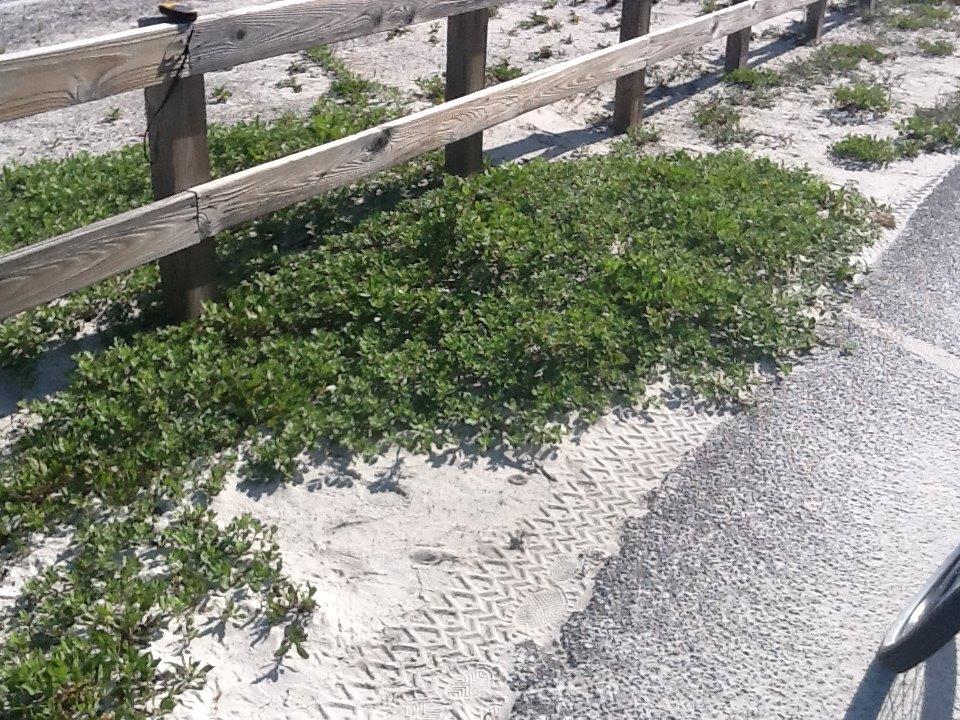
by Carrie Stevenson | Jul 21, 2014

Many beachfront dwellers have intentionally planted beach vitex because of its attractive purple flowers. Photo credit: Rick O’Connor
Now that summer is in full swing, many of us are spending more time on our gorgeous Gulf beaches. Sea turtles are nesting and everyone gets excited at sightings of dolphins, sharks, and the Blue Angels. However, we have another recent visitor to our beaches, and this one isn’t spending money and renting condos. It has moved in from out-of-state and plans to stay, potentially wreaking havoc to our fragile beach dune ecosystems.
Florida is no stranger to invasive species. Reports and stories of pythons, popcorn trees, feral pigs, and others can be found everywhere. As a matter of fact, Florida and Hawaii have more problems with exotic plants and animals than any of the other states.
Beach Vitex (Vitex rotundifolia) is originally from the coastal areas of the western Pacific. It was brought to the United States by North Carolina State University in the 1980’s to restore dunes along coastal Carolina after severe storms. The plant is very salt and drought tolerant and performs well in direct sun and sandy soils; perfect for our coastal beaches. It grows about 3 feet tall and produces branches that extend along the surface of the sand over 60 feet from the tap-root. The flowers are lavender and found in the spring. By midsummer the flowers have dropped and pea-size dark fruit is produced. The fruit is also salt tolerant and can be carried by ocean currents as well as birds. The plant seemed a perfect choice for restoration projects.
And then…
And then it began to overgrow the primary dune system, choking the majority of the native plants including sea oats. The shrub size of the plant and the presence of vertical tap roots in lieu of fibrous ones did not suit it well as a dune forming plant; some studies found that it actually increased the erosion of some dune fields. Beach vitex releases allelopathic compounds, reducing the water content of the soil which stresses native plants thus reducing competition for space. And then there are the sea turtles. Evidence indicates that the growth of this plant over the primary dunes has made it difficult for female turtles to find nesting areas, while fast growing branches grow over incubating nests and make it difficult, if not impossible, for the hatchlings to emerge. The plant has become such a problem that it has been dubbed “Beach Kudzu” and there is a two-state task force to remove it.
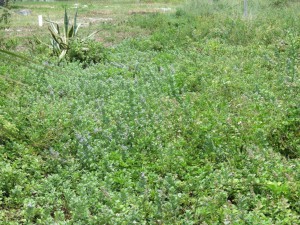
Beach vitex grows quickly and can rapidly take over an entire yard or beach dune. Photo credit: Rick O’Connor
Beach vitex has dispersed north to Virginia and south into Georgia. Currently it has been reported in only three Florida counties; Duval, Santa Rosa, and Escambia. Because of the few records in our state it is not currently listed as an invasive plant in Florida. The problem is, most biologists will tell you that the best way to eradicate an invasive species is to get it early. However most do not see the introduction of a new plant or animal as invasive until it becomes established and difficult to remove.
Natural Resource Agents with UF IFAS Extension are tracking the locations along the coast of the panhandle where this plant may exist. If you believe you may have it please let us know so that the location can be recorded. If you are interested in removing the plant we recommend cutting back to the tap-root. Dab the remaining tap-root with Round-Up. It is best if the remaining parts of the plant do not leave the property; if legal it is ok to burn. If you must transport it off the property we recommend it be dried on concrete and then double bagged before removing to the landfill. In many cases it may take several years to completely remove this plant. If you have any questions about this plant please call your local county Extension Office. Special thanks to Sea Grant Agent Rick O’Connor roc1@ufl.edu for use of this article.
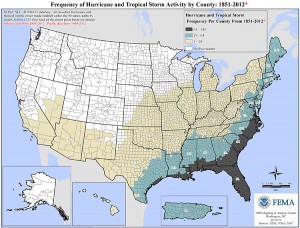
by Carrie Stevenson | Jun 23, 2014
Since the heavy flooding in late April of this year, many property owners have expressed concern to me and their local government officials about their neighborhood’s vulnerability to flooding. Homes and landscapes are most people’s largest investment, and the damage caused by a major storm can be financially and emotionally devastating.

This map shows Florida’s extreme vulnerability to hurricanes and tropical storms, compared with the rest of the country. Graphics courtesy FEMA
To say that Florida is prone to flood is an understatement, at best. Between 1851 and 2012, every county in our state endured between 65 and 141 tropical storms and hurricanes. Many counties average one named storm every 1.1 years. While other states have coastal regions vulnerable to hurricanes, the entire state of Florida lies within FEMA’s highest designation of storm frequency. With hurricane season just beginning and record-breaking flood events in April, it is wise to consider flood insurance. Regular homeowners’ insurance policies do not cover damage related to flooding. Many homeowners go without flood insurance because their home is “high and dry” or “not in a flood zone.” It can be argued, however, that as a Floridian, particularly one in a region of the state with the highest annual average rainfall, you’re in a flood zone—it’s just a matter of whether you’re high or low risk. And, as we’ve seen recently, even those who thought they were low risk could be vulnerable.
Flood insurance is often very inexpensive for those outside of officially designated Special Flood Hazard Areas (think waterfront homes, low-lying property, creek floodplains, and barrier islands). Rates can be as low as $130/year for basic coverage in a low-risk area. It’s simple to get a ballpark figure for potential flood insurance costs by entering your address into a one-step “risk profile” online. According to the National Flood Insurance Program’s (NFIP) website, a quarter of NFIP flood insurance claims and third of Federal Disaster Assistance each year goes to residents outside a mapped high-risk flood zone . When the expenses related to flooding, including removal of flooring, walls, furniture, and damage to plumbing and wiring, are taken into consideration, flood insurance can be a smart investment.

Intense flooding can strike in unexpected locations during heavy rainstorms and tropical storms. This Pensacola street had never experienced serious flood damage prior to April 2014, so most residents did not have flood insurance. Photo credit: Carrie Stevenson
Timing is important, too, because a 30-day waiting period is often required before flood insurance coverage kicks in. If you are also looking at additional windstorm insurance, be aware that policies will not be sold if a storm is in the Gulf. It is important to act sooner than later, but if you start now you can have flood and windstorm coverage in place before August and September. Our most severe storms historically occur during these months, after the Gulf has had all summer to warm up.
To purchase flood insurance, contact your local agent, find an agent online at www.floodsmart.gov, or call 1-888-379-9531. Be sure to ask exactly what is covered and under what circumstances, as there are many particularities to flood insurance. For up-to-date information on recent changes to the NFIP, please visit Coastal Planning Specialist Thomas Ruppert’s webpage.
Disclosure: The University of Florida/IFAS Extension program cannot make specific recommendations on insurance agents or providers. Please make the best decision for your home and family to prepare for storms and flooding.













